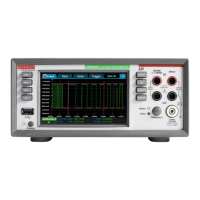3: Using a remote interface DMM6500 6½ Digit Multimeter
3-2 DMM6500-900-01Rev. A / April 2018
Supported remote interfaces
The DMM6500 supports the following remote interfaces:
• GPIB: IEEE-488 instrumentation general purpose interface bus
• Ethernet: Local-area-network communications
• RS-232: Serial communication data standard
• USB: Type B USB port
• TSP-Link: A high-speed trigger synchronization and communications bus that test system
builders can use to connect multiple instruments in a master-and-subordinate configuration
The GPIB, RS-232, and TSP-Link interfaces require an optional communications accessory card to
be installed in the instrument. Accessory cards include the KTTI-GPIB, KTTI-TSP, and KTTI-RS232.
For details about TSP-Link, see "TSP-Link System Expansion Interface" in the Model DMM6500
Reference Manual.
The rear panel connections for the remote communication interfaces are shown in the following
figure.
Figure 15: DMM6500 remote interface connections
LAN communications
You can communicate with the instrument using a local area network (LAN).
When you connect using a LAN, you can use a web browser to access the internal web page of the
instrument and change some of the instrument settings. For more information, see
Using the web
interface (on page 3-15).
The DMM6500 is a version 1.5 LXI Device Specification 2016 compliant instrument that supports
TCP/IP and complies with IEEE Std 802.3 (ethernet LAN). There is one LAN port (located on the rear
panel of the instrument) that supports full connectivity on a 10 Mbps or 100 Mbps network. The
DMM6500 automatically detects the speed.
The DMM6500 also supports Multicast DNS (mDNS) and DNS Service Discovery (DNS-SD), which
are useful on a LAN with no central administration.

